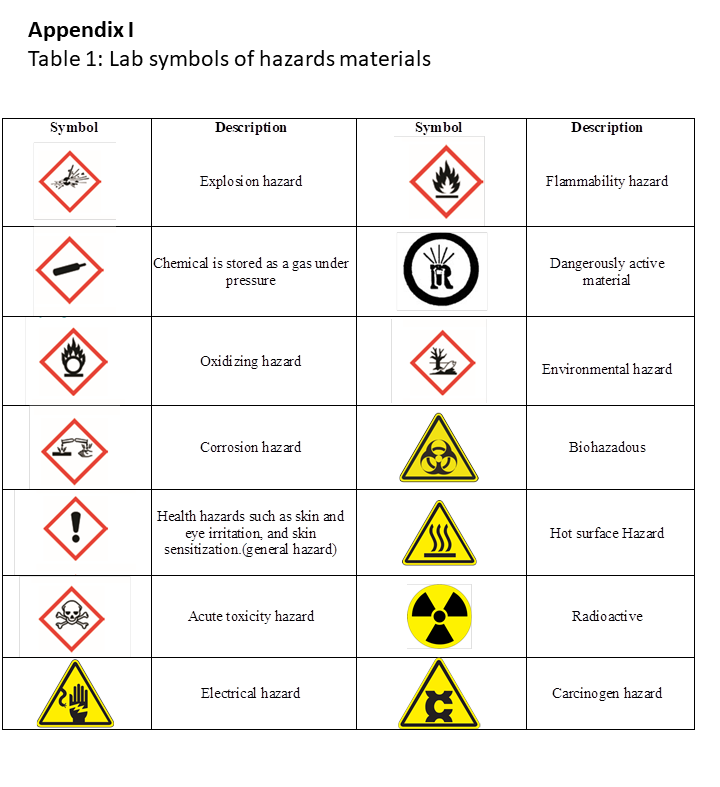[ Faculty Of Pharmacy ]
Facilities
Appendices
Appendix I

Appendix II
Table 2: types of waste in lab with their suitable waste containers
Waste type | Waste container | Photo |
Chemical solvents and liquids | 5L HDPE residue container (approved) |  |
Contaminated Material which has hazardous material adhered | Laboratory Contaminated Material bin |  |
Filter paper Gloves Tissues Glass | Waste Contractor Contaminated Waste bin |  |
Sample vials containing less than 2g hazardous material | Hazardous sample vial waste container |  |
Old or unlabelled chemicals in supplier bottles | These bottles can be taken directly to waste pick up, ensuring that a waste tracking log is completed. Special collections of high risk or unlabelled material can be arranged. |  |
Broken Glass (chemically clean, including domestic glass) | Half-size yellow or grey SULO bins Small bin with lid, temporary storage |  |
Contaminated Sharps Sharps | In a sharps container and bagged according to the type of contamination (biohazardous, radioactive, cytotoxic) Yellow sharps containers |  |
Biohazardous | In Yellow bags or containers labeled with black biohazard symbol |
|
Appendix III
First Aid & Emergency Procedures:
In case of accidents and emergency situation, it is important not to panic and report it immediately to you supervisor. In addition to that:
You need to learn where and how to use safety devices, including: Eye Wash Station -Breathing Apparatus – Spill Cleanup Materials – First Aid Kit – Fire Alarm – Fire Extinguisher.
You need to know all the special label that describe the hazard effect of materials, such as flammable, corrosive or explosive.
Always maintain a clear path to all safety equipment at all times.
In case of wounds:
Never touch an open wound without wearing gloves.
Clean the wound with water as appropriate.
In case of small cut, place a sterile pad over wound and apply gentle pressure evenly with the opposite hand.
Rise the area injured above the level of the heart if the bleeding did not stop.
Take the patient to hospital or ask for help from medical team in the university.
In case of Burns:
Thermal burns
First degree burns: redness or discoloration of the skin, mild swelling and pain are the characters of first degree burns. Immersing or raining with water for 10 minutes can be enough. Creams can be applied.
When the burn result in red or scared skin with blisters (second degree), or, white or charred skin (third degree), immediate cleaning of the area is necessary when possible and transfer to hospital.
Chemical Burns
1. If chemicals come in contact with skin, remove the chemical right away and rinse the affected area with large quantities of water for at least 15 minutes.
2. In case of eyes contamination, rinse them with running water for at least 15 minutes at the eye wash station.
3. In either situation, medical advised should be asked immediately.
In case of ingestion of a toxin:
Poisoning caused by swallowing chemicals, can be overcome by diluting the stomach contents with large quantities of water.
Try to know what was the material ingested.
Immediate Medical treatment.
In case of inhalation of chemical fumes:
Take the individual to fresh air.
Provide an artificial respiration if needed.
Immediate medical treatment.
Fire:
If clothing is on fire, help the individual to the floor and roll him/her around to smother the flames, or if a safety shower is immediately available, douse the person with water. Seek medical attention.

